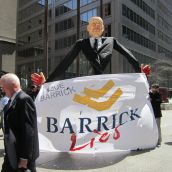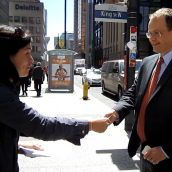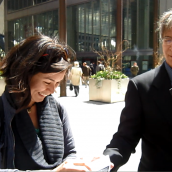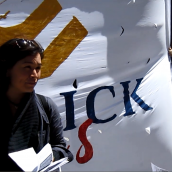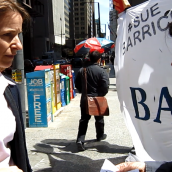On September 8 and 9, 2009, Barrick announced the largest common stock offering in Canadian history. They sold around $4 billion in stock that month at fraudulently inflated prices, according to a class action filed against Barrick last week in Ontario Courts.
So on Monday at lunchtime, activists hit the finance district, equipped with a giant puppet and hundreds of informative fliers to instigate shareholder rage against Barrick and direct it towards this class action.
The action, brought by Koskie Minsky LLP and Sutts, Strosberg LLP, is open to purchasers of Barrick securities from May 7, 2009 to November 1, 2013 and seeks $6 billion in damages, amounting to over a quarter of Barrick's market cap ($20.84 Billion). While this may seem excessive, Barrick's market cap was valued at over $48 Billion from 2011 until 2012.
The class action claims that investors lost billions of dollars because Barrick made misrepresentations and failed to disclose important information – in Barrick's possession – regarding cost estimates and time frame for Barrick's flagship Pascua Lama project, on the border of Argentina and Northern Chile.
For example, at the time of their big $4 billion stock sell-off, Barrick estimated the pre-construction cost of their flagship project, Pascua Lama, at $2.8-3 billion. They promised that "fully compliant environmental management and monitoring plans" had been developed, and that production was expected in early 2013. But, by the time early 2013 rolled around, costs had ballooned upwards of $8.5 billion, and then to make matters worse (for Barrick) authorities suspended the Pascua Lama due to serious environmental damage caused by the mine. A couple of months later, Barrick took a $5.5 billion writedown on Pascua Lama and eventually suspended their flagship project indefinitely.
Court documents filed by Labaton Sucharow LLP in a similar class action in the United States reveal the testimonies of five former Barrick employees. These confidential witnesses confirm that Barrick top management knew that construction at the Pascua Lama Project was contaminating nearby water sources and breaching environmental conditions that led to the suspension of the project. These witnesses also testify that at a time when the company was estimating that the Project's cost would be between $2.8 and $3 billion, Barrick already had in its possession an engineering report estimating costs for the Project at nearly twice that figure.
The suspension of Pascua Lama thrilled activists working to protect the fragile and arid Huasco Valley, where the main industry is argiculture. This unpopular project has been fought for over a decade by environmentalists, farmers, and the Indigenous Diaguita from Northern Chile.
The Pascua Lama conflict isn't the only community conflict within which Barrick is embroiled, and on the flipside of the fliers that activists handed to people on Bay St, some of these conflicts were described alongside a call to protest Barrick at their annual general meeting on April 30.
This annual general meeting is taking place while:
• Barrick is facing a
case in the British High Court seeking damages for the death and injury of local villagers near Barrick's North Mara mine in Tanzania.
• Communities in Papua New Guinea are making
urgent calls for resettlement away from the mine site and community members are compensation for killings and sexual assault.
• Communities in the Dominican Republic are also seeking urgent relocation away from the contaminated mine site, and to be compensated for their economic losses from dead cattle and contaminated produce.
• Indigenous Diaguita communities in Chile are fighting to stop the Pascua Lama project, which does not have their consent and has been poisoning their scarce water resources.
• Communities on Marinduque Island in the Philippines are
seeking damages from a mine tailings disaster, considered the worst mining disaster in the Philippines.
Whether you're a community impacted by Barrick's mines, or a shareholder (like the
Ontario Teachers Pension Plan) who has lost 60% of their share value, many people can find common cause in fighting Barrick Gold.
While it is definitely an injustice that shareholders, and not community members, can sue for damages to land belonging to the Indigenous Diaguita, there are activists in Canada that are trying to change this dynamic. The
Open For Justice campaign would allow non-Canadian citizens to access Canadian courts to sue for abuses that occured abroad, and is an important step towards creating accountability for abuse in a globalized world.
